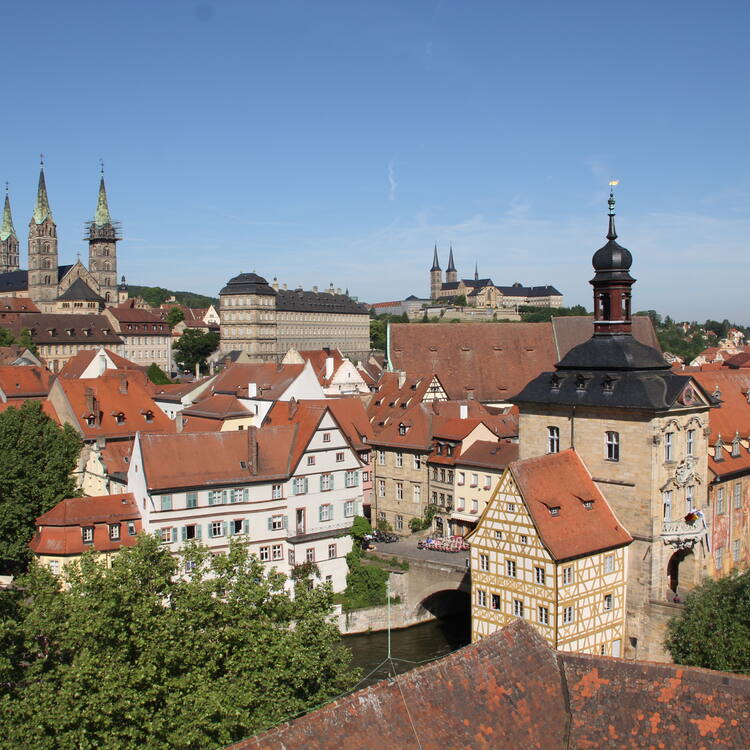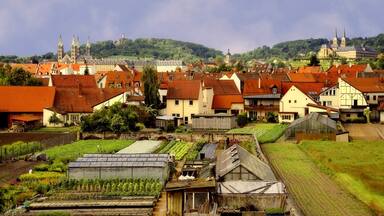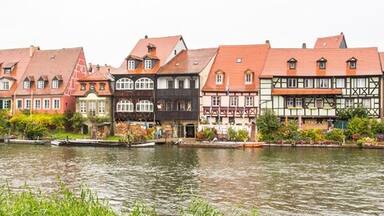Town of Bamberg
Town of Bamberg
From the 10th century onwards, this town became an important link with the Slav peoples, especially those of Poland and Pomerania. During its period of greatest prosperity, from the 12th century onwards, the architecture of Bamberg strongly influenced northern Germany and Hungary. In the late 18th century it was the centre of the Enlightenment in southern Germany, with eminent philosophers and writers such as Hegel and Hoffmann living there.
Description is available under license CC-BY-SA IGO 3.0
Ville de Bamberg
Depuis le Xe siècle, cette ville est devenue un lien important avec les peuples slaves d'Europe de l'Est, spécialement ceux de Pologne et de Poméranie. Durant sa période de prospérité, à partir du XIIe siècle, l'architecture de Bamberg a fortement influencé l'Allemagne du Nord et la Hongrie. À la fin du XVIIIe siècle, c'était le centre des Lumières pour le sud de l'Allemagne, avec des philosophes et écrivains éminents comme Hegel et E.T.A. Hoffmann.
Description is available under license CC-BY-SA IGO 3.0
مدينة بامبرغ
منذ القرن العاشر، أصبحت هذه المدينة أحد أهم الروابط مع الشعوب السلافية القادمة من أوروبا الشرقية، لا سيما من بولندا وبوميرانيا. خلال فترة الازدهار التي عرفتها مدينة بامبرغ وبشكل خاص منذ القرن الثاني عشر، أثّرت هندستها المعمارية بشكل كبير على المانيا الشمالية والمجر (هنغاريا). وفي نهاية القرن الثامن عشر، اعتُبرت مركز الأنوار بالنسبة إلى جنوب ألمانيا، لا سيما وأن فلاسفة وكتابا مهمين على غرار هيغل و إ.ت.أ هوفمان انبثقوا منها.
source: UNESCO/CPE
Description is available under license CC-BY-SA IGO 3.0
班贝格城
从公元10世纪开始,这座城市就成为联系斯拉夫民族,尤其是波兰人和波美拉尼亚人的重要纽带。自12世纪以来,在其鼎盛时期,班贝格城的建筑风格对德国北部和匈牙利产生了极大影响。18世纪末,班贝格城成为德国南部启蒙运动的中心,吸引了黑格尔和霍夫曼等知名的哲学家和作家来居于此。
source: UNESCO/CPE
Description is available under license CC-BY-SA IGO 3.0
Город Бамберг
Начиная с X в. этот город являлся важным связующим звеном со славянскими народами, особенно из Польши и Померании. В период наибольшего расцвета, начавшегося с XII в., архитектура Бамберга оказывала большое влияние в северной Германии и Венгрии. В конце XVIII в. город стал центром просвещения в южной Германии, где жили выдающиеся философы и писатели, такие как Гегель и Гофман.
source: UNESCO/CPE
Description is available under license CC-BY-SA IGO 3.0
Ciudad de Bamberg
A partir del siglo X, Bamberg constituyó un importante punto de contacto e intercambios con los pueblos eslavos de Europa Oriental, en particular los polacos y los pomeranos. En su época de prosperidad, iniciada en el siglo XII, su arquitectura ejerció una influencia considerable en la del norte de Alemania y Hungría. A finales del siglo XVIII, Bamberg se convirtió en el foco principal de la Ilustración del sur de Alemania. Contó entre sus ciudadanos a filósofos y escritores ilustres como Hegel y Hoffmann.
source: UNESCO/CPE
Description is available under license CC-BY-SA IGO 3.0
バンベルクの町
ドイツ南部、バイエルン州の都市。900年ごろ開かれ、11世紀初頭には司教座が設けられ、オットー朝の中心都市となるとともに、大聖堂が建立された。13世紀にはランス大聖堂の双塔を模するなど、ロマネスクの面影を濃く残しつつゴシック様式で再建された。ゴシック時代からルネサンスにかけて経済的にも栄え、有名な市庁舎、広場などが立ち、17~18世紀には新宮殿、ベッテインガーハウスが建立された。source: NFUAJ
Bamberg (stad)
Bamberg werd vanaf de 10e eeuw een belangrijke schakel met de Slavische volkeren, in het bijzonder met die uit Polen en Pommeren. Tijdens de periode van de grootste welvaart – vanaf de 12e eeuw – heeft de architectuur van de stad Noord-Duitsland en Hongarije sterk beïnvloed. In de late 18e eeuw was Bamberg het centrum van de Verlichting in Zuid-Duitsland; De vooraanstaande filosoof Hegel en auteur Hoffmann woonden er. Het is nooit een industriestad geworden omdat handel, met name in hop, de economische basis bleef. Bamberg is een toonbeeld van een Midden-Europese stad met een middeleeuws stadsontwerp en veel bouwwerken uit die tijd.
Source: unesco.nl
Outstanding Universal Value
Brief synthesis
Bamberg is located in southern Germany in the north of Bavaria. It is a good example of a central European town with a basically early medieval plan and many surviving ecclesiastical and secular buildings of the medieval period. When Henry II, Duke of Bavaria, became King of Germany in 1007 he made Bamberg the seat of a bishopric, intended to become a 'second Rome'. Of particular interest is the way in which the present town illustrates the link between agriculture (market gardens and vineyards) and the urban distribution centre.
From the 10th century onwards, Bamberg became an important link with the Slav peoples, especially those of Poland and Pomerania. During its period of greatest prosperity, from the 12th century onwards, the architecture of this town strongly influenced northern Germany and Hungary. In the late 18th century Bamberg was the centre of the Enlightenment in southern Germany, with eminent philosophers and writers such as Georg Wilhelm Friedrich Hegel and E.T.A. Hoffmann living there.
Criterion (ii): The layout and architecture of medieval and baroque Bamberg exerted a strong influence on urban form and evolution in the lands of central Europe from the 11th century onwards.
Criterion (iv): Bamberg is an outstanding and representative example of an early medieval town in central Europe, both in its plan and its surviving ecclesiastical and secular buildings.
Integrity
The medieval layout of the city with its three settlement areas is still well preserved. The property therefore contains all elements necessary for the Outstanding Universal Value. There are no adverse impacts of development and/or neglect.
Authenticity
The street layouts of the three historic core areas retain their medieval features. The many historic buildings in these areas are authentic. Since the 1950s Bamberg has undergone a continuous programme of restoration of its historic properties and areas. This programme proceeded by a series of small projects (the “Bamberg model”) rather than by large and ambitious schemes resulting in the uniformly high level of conservation of Bamberg.
Protection and management requirements
The laws and regulations of the Federal Republic of Germany and the Free State of Bavaria guarantee the consistent protection of the Town of Bamberg. The legal basis for the whole of the World Heritage property and the Buffer Zone is manifested in the Bavarian Preservation of Monuments Act. The national Town and Country Planning Code is considered for intra-urban construction projects. The boundaries of the Town Ensemble, the World Heritage property and the Buffer Zone are officially included in the land use plan. Within the Town Ensemble numerous single listed monuments and landscape protection areas are to be found. Additionally, the large-scale Town Ensemble designation protects the integrity of the World Heritage property. Historic properties have been conserved in accordance with accepted conservation practices within the regional programme “the Bamberg model” for preservation.
The City of Bamberg is the responsible institution for the management of the property. For this specific task the so-called Centre of World Heritage Bamberg has been established. The Centre coordinates the protection and preservation of the physical substance and intangible heritage which is linked to the built structure. A study of visual axes will be the basis for an enlargement of the Buffer Zone. Once finalized and approved, a sustainable Management Plan will be in place.
Links
-
TripAdvisor, Zentrum Welterbe Bamberg
-
Facebook page
-
Instagram account
-
City of Bamberg - Bamberg World Heritage Office (in English and German)
-
Tourism & Congress Service (in English and German)
-
UNESCO Commission of Germany (in English only)
-
Altstadt von Bamberg (Deutsche UNESCO-Kommission) (in German only)
-
Town of Bamberg (Town Council of Bamberg) (in German only)





